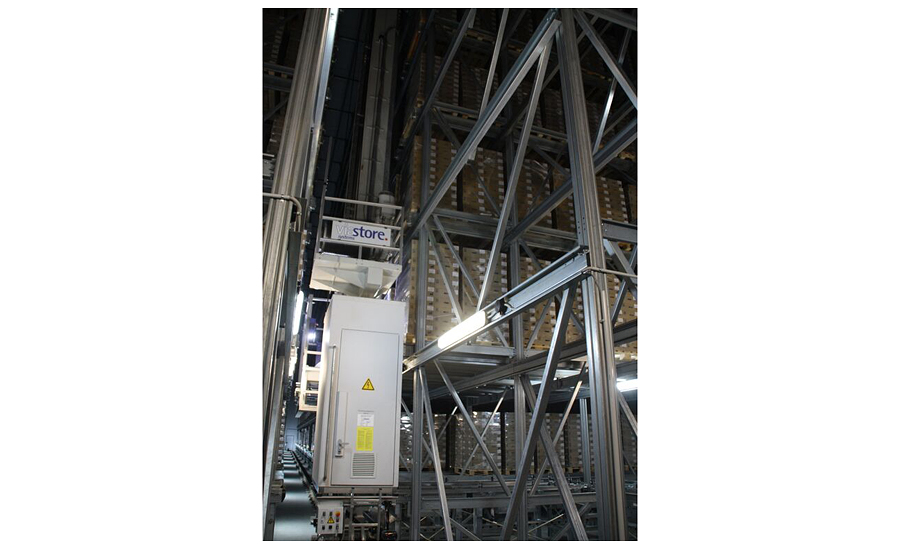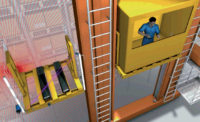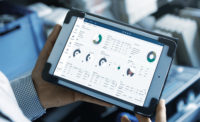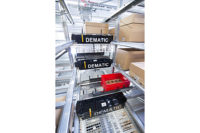When Americold needed to expand its facility space to better serve regional customers from its Indianapolis, Ind., the Atlanta-based third-party logistics (3PL) provider of temperature-controlled warehousing and logistics services to the food industry looked up.
“Having previously expanded a conventional warehouse on this property, we had essentially run out of space to build out,” says David Bridger, Americold’s AS/RS operations manager at the Indianapolis location. “So, in 2011, we worked with viastore systems to design and build a 110-foot-tall rack-supported building with a conveyor-fed pallet handling automated storage and retrieval system (AS/RS) to utilize the vertical space.”
The conventional facility already housed 28,000 pallet positions across 440,000 square feet; when the AS/RS building opened, it added another 21,000 pallet positions in just over 96,000 square feet. The AS/RS was initially engineered to automatically replenish multi-level order picking positions integrated within the racking structure and pick tunnels at floor level.
The AS/RS also interfaces with a pallet conveyor system for automatic receipt and delivery of pallet loads into and out of the system for storage, outbound staging and order replenishment. For inventory control and order/workflow management, viastore’s AS/RS and conveyor control system, viad@t, communicates with Red Prairie warehouse management system, managed by JDA Software Group, Scottsdale, Ariz., on the AS/RS side of the facility (the conventional side runs a legacy AS400 WMS but will be converted in the next WMS conversion wave).
viad@t directs receipt of pallets through put away to designated storage locations and retrieves pallets to replenish pick locations and fulfill full pallet shipments.
Among the unique features of the AS/RS building, its six aisles are divided into two separate temperature zones. This allows Americold to convert either two or four aisles from freezer to cooler temperatures of 0-34°F (viastore specifically engineered the mechanical and electrical hardware to withstand temperatures as low as -10°F). Temperature changeovers only require an oil change in the motors and reducer drives running the cranes and conveyors.
Multiple temperature zones are also utilized in the conventional warehouse.
“That allows us to accommodate customers with a wide variety of products, including meats, dairy, fruit, vegetables, processed and pre-packaged foods,” says Bridger.
A new problem
Within six months of opening the new AS/RS facility, however, the productivity levels that Americold had anticipated weren’t being achieved.
“The customer we had intended to serve with the new facility made some changes to their requirements and order profile that better suited a non-AS/RS solution we could accommodate in another building at our Indianapolis complex. We decided to locate a different customer in the AS/RS instead,” says Bridger. “Although the initial design had some flexibility engineered into it, we became aware of the system’s limitations during the ramp-up phase of the new customer’s business. The AS/RS was originally intended to handle single-stacked cooler pallets, but the new customer needed us to handle double-stacked freezer pallets.”
The customer’s need for a high volume of half-pallet loads to be shipped out to stores and store distribution centers increased case-picking requirement to near 38% of all handling activity for the customer. The high case pick percentage required associates to pull less-than-pallet-load quantities both in the pick tunnels and overhead. And, with double-stacked pallets reaching heights of 90-plus-inches, the ergonomics weren’t ideal. This process was counter-intuitive to the reasons behind implementing the AS/RS.
Compounding the picking inefficiencies, “the conveyor loop that fed and returned pallets from the dock frequently became congested or gridlocked,” Bridger adds. “That affected service windows and stressed the dedicated team handling the account.”
Even when Americold tried to compensate by case picking 6-8 hours ahead of a scheduled trailer arrival, dock congestion further complicated the loading and unloading process, adding even more handling time and expense.
“Ultimately, the system could not meet the new customer’s increased throughput demand. It also could not consistently retrieve pallets in short time windows,” Bridger says. “We called viastore back to help us figure out these issues.”
The new and improved solution
The Americold team spent two months analyzing and evaluating their previous six months of AS/RS operational data. When the viastore team was brought back in, the two companies worked together to conceptualize a variety of potential solutions. The options were run through viastore’s simulation software to vet the potential changes and spot possible bottlenecks.
“Running our potential solutions through their simulation program was really unique and very, very helpful,” says Bridger. “We threw ideas at viastore, and they would run the simulations, then report back to us with the results and the tweaks they made. They showed us how to make our modification ideas work. It was a real collaborative, cohesive effort because they not only understood our business, but also where the automation should fit in, particularly since our customer’s needs had changed.”
Profiling the needs of each Americold customer and its order profiles and stock keeping unit (SKU) velocities was one of the first areas of review, says Bill Ostermeyer, viastore’s vice president of sales.
“It became apparent that they wanted to do more case picking for higher volume SKUs in the AS/RS, which really works better for slow-to-medium movers rather than faster moving case-pick items,” Ostermeyer says. “But, their adjacent conventional warehouse gives Americold the opportunity to bypass the AS/RS for fast-moving items. As a 3PL, having that hybrid setup gives them the flexibility to fluctuate between multiple types of handling profiles.”
The selected upgrade solution called for a dedicated de-coupling area to eliminate the extra labor required to achieve the required half-pallet loads.
“The new de-couple area is a separate room where we pull double-stacked pallets out of the AS/RS’s reserve storage, separate them and send half stacks to either shipping, case picking or back to reserve storage,” explains Bridger. “By down-stacking double-stacked pallets outside of the AS/RS, we’ve reduced the amount of case picks and can now send half-pallet quantities directly to shipping. This is a significant time saving over manually picking half-pallet volumes.”
Additionally, the de-couple area has become a semi-automated process to reduce labor requirements. It allows Americold to accommodate various pallet heights and dividers, including slipsheets, damaged pallets or tall-stacked pallets with no dividers at all.
Further, the conveyor system was modified to provide multi-direction crossovers. That enables pallets to be more quickly returned to the AS/RS cranes or exit the system, as well as better accommodating both inbound and outbound inventory surges—reducing the congestion previously experienced on the conveyor loop. The de-couple area was designed to allow both in-feed and out-feed if front dock conveyors or the pallet elevators feeding the conventional side of the building become congested or go down.
“The new modifications allow for automated replenishments to the conventional side of the building, letting us add more SKU pick faces outside of the existing pick tunnels under the AS/RS,” Bridger adds.
Also, all of the pallet storage positions in the AS/RS were redesigned with 100-inch-tall openings to accommodate tall- or double-stacked pallets for extra flexibility.
“We have the option of coming back and adding some shorter pallet storage heights for greater storage density in the future,” Bridger adds.
Still in progress, an additional modification to the AS/RS repurposes the original pick tunnels to create a pack-and-hold area. When complete, this will allow Americold to pick loads ahead of time but keep them stored within the AS/RS—rather than at the dock—until the shipping trailer arrives to receive the load. This keeps the dock area clear for unloading, cross-docking, loading and value-added services while still enabling rapid recall of pallets required for loading from the AS/RS.
Finally, the software interfaces were modified for more timely communication between the viad@t AS/RS control system and Americold’s RedPrairie WMS.
The upgrade took roughly nine months, start to finish, says Bridger. The bulk of the updates went live by September 2014 and the additional modifications to the pack-and-hold area are anticipated to be complete by summer 2015.
The results
“Almost immediately upon completion of the upgrade, Americold was able to better manage the needs of their customer more effectively and with less labor,” says Bridger.“Our case picking has been cut by 50%, now that half-pallet picks go directly to shipping; instead of being 38% of the handling work required for that customer, we’re now down to around 18%-19%. Also, our labor efficiency has been increased by 25% mostly due to elimination of handling steps.”
From an ergonomic perspective, adding the semi-automated de-coupling area has eliminated exertion for operators while case picking, thus increasing associate safety. Further efficiencies have been documented in throughput.
“Crane capacity per day has increased by 43% year over year,” Bridger adds. “During the peak of last year after the changes, we averaged 2,461 moves per day vs. 1,715 moves in the same 3-month period of 2013.”
Although the AS/RS is currently dedicated to a large key account customer, the upgrades have added enough flexibility within the AS/RS that Bridger says it could be easily adapted to handle the needs of as many as 10-20 customers.
Overall, Americold has been very pleased with the results. For other 3PL companies considering a transition from conventional to automated handling—or the addition of automation to an existing conventional process—Bridger advises partnering with a vendor that understands an operation’s current business and possible future needs.
“You need people with an in-depth knowledge of automated system capabilities and software interfaces. This includes good engineers, project managers and information technology design talent who understand that you cannot run an automated system the same way as you run a conventional system,” he says. “Automated systems require a greater amount of flow and inventory control discipline. You cannot just release orders to the floor or AS/RS without understanding how each area is running or backlogged. Each zone’s capacities must be understood, so as not to overrun one side or the other.”
Likewise, Bridger stresses the importance of managing internal expectations—particularly with regard to labor rate goals.
“It might take as long as 10 months after the completion of a complex automation system to hit 100% of your staffing targets,” he adds. “Company expectations must be managed to this, otherwise, executive management might believe a system has under-delivered.”
The Indianapolis location was Americold’s first implementation of an automated pallet storage system. Now that the productivity challenges in the Indianapolis AS/RS facility have been resolved, the company is currently looking to add more AS/RS locations elsewhere within its network.



